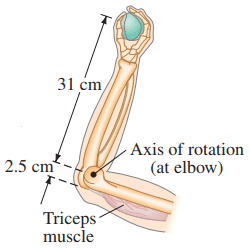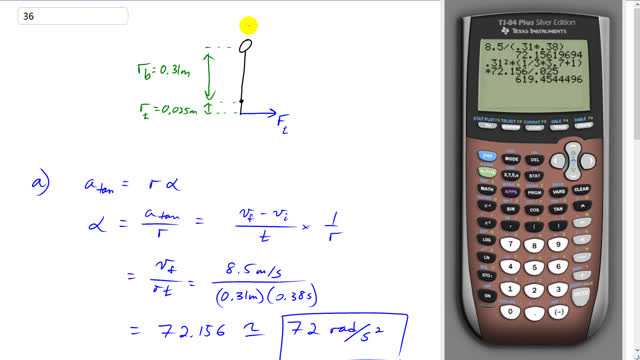
Assume that a 1.00-kg ball is thrown solely by the action of the forearm, which rotates about the elbow joint under the action of the triceps muscle, Fig. 8–46. The ball is accelerated uniformly from rest to 8.5 m/s in 0.38 s, at which point it is released. Calculate
- the angular acceleration of the arm, and
- the force required of the triceps muscle. Assume that the forearm has a mass of 3.7 kg and rotates like a uniform rod about an axis at its end.


In order to watch this solution you need to have a subscription.
This is Giancoli Answers with Mr. Dychko. The angular acceleration of the arm and the ball are all the same because they are all connected and going in the same circle. So we can use this data to do with the ball and then that will answer our question for the angular acceleration of the arm. So the tangental acceleration equals radius times angular acceleration and we can solve this for angular acceleration and by dividing both sides by r and so we have angular acceleration for the arm will be, or for the ball, will be the tangental acceleration of the ball divided by its distance from the pivot and here's the formula we can use for its tangental acceleration its final velocity minus initial divided by time where initial velocity is zero in which case this just becomes v f over t and instead of dividing this fraction by something, I'm gonna multiply by the reciprocal here. So we are gonna multiply by the reciprocal of the denominator so times by 1 over r— just makes it look a little bit cleaner— and then we can write it in this form so we have v f over r t. So the angular acceleration then is 8.5 meters per second— the final speed of the ball— divided by its distance from the pivot the elbow of 0.31 meters and then divide by 0.38 seconds and that gives 72 radians per second squared is the angular acceleration of the ball and therefore also that of the arm. Now for the force exerted by the tricep, the torque needed to accelerate the ball-arm system is the ball-arm system's moment of inertia mutliplied by its angular acceleration and that torque is provided by the tricep so it also equals the tricep force applied times its lever arm and since the force of the lever arm's at right angles, we don't have to be concerned with any sin Θ here because sin of 90 which is 1. So these are both equal to the torque which means these two things are equal to each other here and we can solve for f t, the force exerted by the tricep, by dividing both sides by the tricep's lever arm. So we get force in the tricep is the total moment of inertia times the angular acceleration divided by the lever arm of the tricep and the moment of inertia is the sum of the moment of inertia for each of the items and there's two things: there's the forearm and there's the ball So the forearm we are told to assume is a uniform rod with an axis of rotation at one end in which case the formula is one-third mass of the arm times the distance or the length of the arm squared. And plus the mass of the ball times the distance from the ball to the pivot squared— that's the moment of inertia for a point mass— add those together and you get the total moment of inertia. Now we can assume that the length of the arm is approximately equal to the distance from the elbow to the ball because while we are told that's where the axis of rotation is and we are told to model this thing as though it's a rod with an axis of rotation at its end so I guess that must be the end of it so in which case, the length of the arm is the same as that of the ball so we won't bother writing 2.5 centimeters there. So in that case, this is a common factor there we can factor out this r b squared. So we have r b squared times one-third mass of the arm plus mass of the ball times α over r t and that gives us 0.31 meters squared times one-third of 3.7 kilograms— mass of the arm— plus—mass of the ball—1 kilogram times 72.156 radians per second squared— angular acceleration of the whole system— divided by 0.025 meters—length of the tricep lever arm— and that gives about 620 newtons.